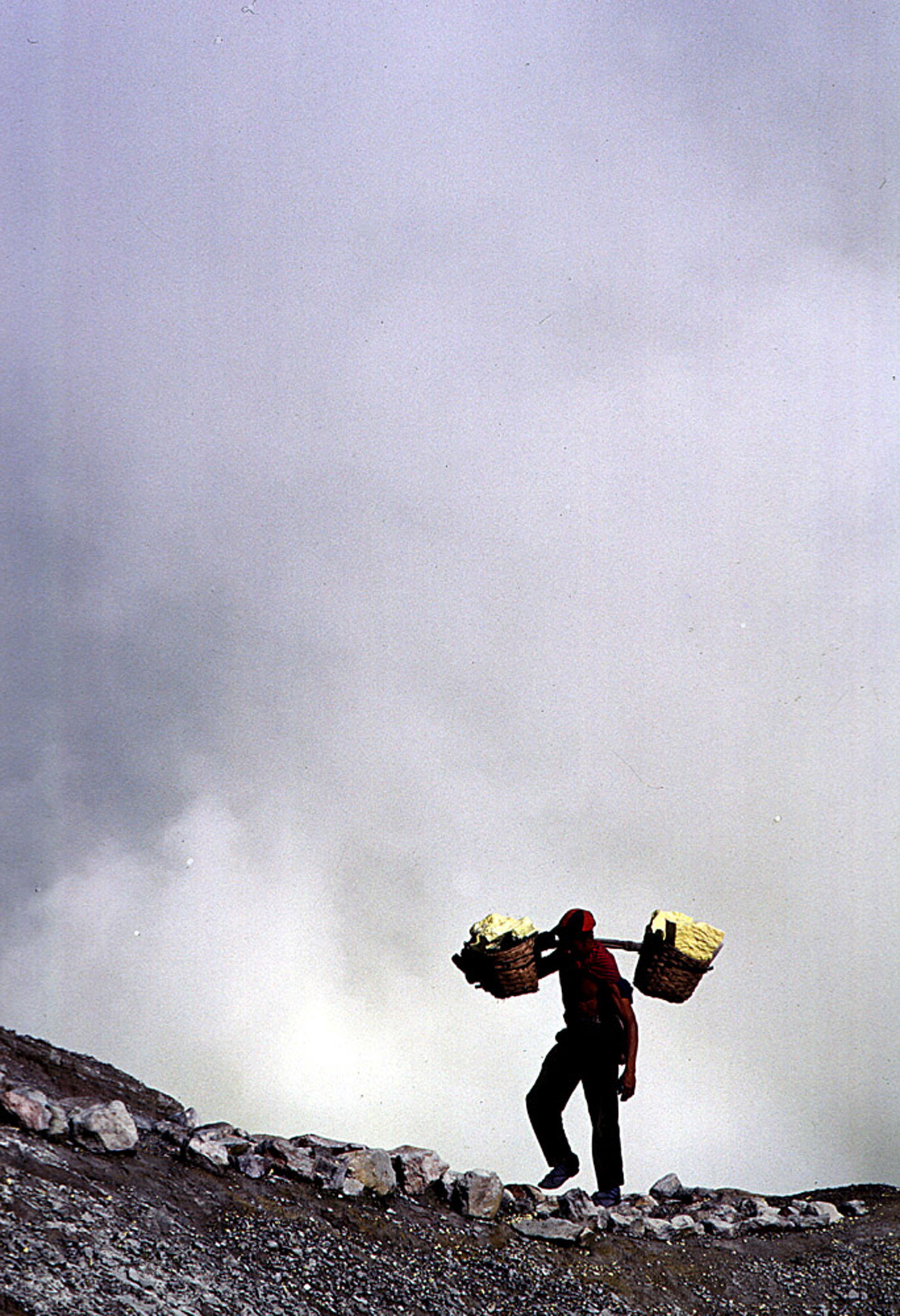Ijen - A Poor Man's Burden

A Poor Man’s Burden - The Sulphur Gatherers of Ijen
Story & photographs by Andy Rain
Making ends meet in over populated islands like Java has always been a way of life for Indonesia’s poor. Times now have become even harder due to the country’s current economic and ethnic strife. Life in general has become that more difficult to sustain. Yet if the majority of Indonesian’s believe their woes are too much to bear they would be wise to take heed from the 300 or so sulphur gatherers that work in the heart of a smoking volcanic crater high on a lonely plateau in eastern Java. Surrounded by Sumatran pines and coffee plantations stands Mount Ijen. At 2400 meters, Ijen is one of six volcanoes that is situated at the far eastern end of Java and was at one time a huge active crater complex, although today Ijen’s crater remains dormant. It last erupted in 1952.
From the crater lip the panorama is unworldly. Falling 800 meters, sheer cliffs are met by a turquoise sulphur lake streaked in wind blown sulphurous vapor far below. However it is not the outlandish topography that makes Ijen so unique. What is so startling about this relatively unknown windswept crater is the way in which men, aged from 17 to 60 struggle to earn a living here. Their toil is so severe and unyielding it borders close to thralldom, and is more reminiscent of a time long past.
Working a one week on, one week off rota, Ijen’s sulphur gatherers rise around 4 am from their wooden huts that lie half way up the mountainside and make their way by foot through awakening forest and finally down the moonscape like crater to the lake edge. Covering their faces with ragged pieces of cloth to protect themselves from the sulphurous vapor that swipes the air from the lungs and burns the eyes, choking groans come from behind the clouds of billowing smoke as men chip away rocks of sulphur, that runs down pipes that scale the crater cliffs. Once the liquid sulphur reaches the atmosphere it turns into a solid bright yellow mass.
Then with as much as one hundred kilo’s, the weight of a large man, balanced in two baskets across their backs they begin the literally grueling step by step ascent to the crater lip high above. Apart from the dangers of staggering unwieldy up the steep volcanic cliff face, workers are subject to respiratory illnesses caused by the choking sulphur fumes and shoulder infections that occur due to the extreme weight put upon their backs, day in day out. “Of course I’d prefer to do something else”, says Mes Nawan, a frail looking 5ft 6in. 48 year old, whose been at Ijen for 30 years, “but I can’t find work that pays enough to educate my three children”, he says. Depending on how many kilo’s he collects, Mes Nawan earns on average about $30 a month. “Although I receive a little more because I’ve put in more than 20 years service”, he says, smoking incessantly.
On reaching the crater lip men proceed another 4 km across mountain ridges and through mist covered forests, stopping now and then to regain their strength. Finally they reach the foothills of the plateau where they weigh their load and take rest before returning for yet another arduous journey. Most workers make 2 or 3 trips each day before ominous rain clouds rolls across the mountains in the early afternoon, making it too dangerous for them to work further.
The Chanding Grimba mining group has been extracting sulphur from Ijen since the early 1960’s. Over 700 tones of the non-metallic element are collected every day. Sulphur has a wide range of applications as a fumigant, preservative and bleach. It is widely used in the chemical and paper industry, in foods and in medicine for treating skin diseases. It is ironic that for all the enormous amounts of sulphur these men carry across their backs each day none have means to buy such medicines they so badly need to treat their own work induced infections.
In a world that prides itself on its technical achievements, Ijen’s sulphur gatherers provide a harrowing view of a world of extremes, and epitomize the kind of primitive working conditions we humans have vowed to eradicate. Population growth is having prolific effects on this widening gap of two distinctly different worlds, which can only exasperate the growing problems of the poor.
The United Nations predicts the world population to be 8.5 billion by 2025, with more than 7 billion living in what are now developing countries. The men of Ijen are a stark reminder to all countries that a nation cannot be modern while its people languish in such medieval work place. Albeit they lead a prosaic simple existence, live extraordinary lives and demonstrate the firm steadfast will of the human spirit.
end


